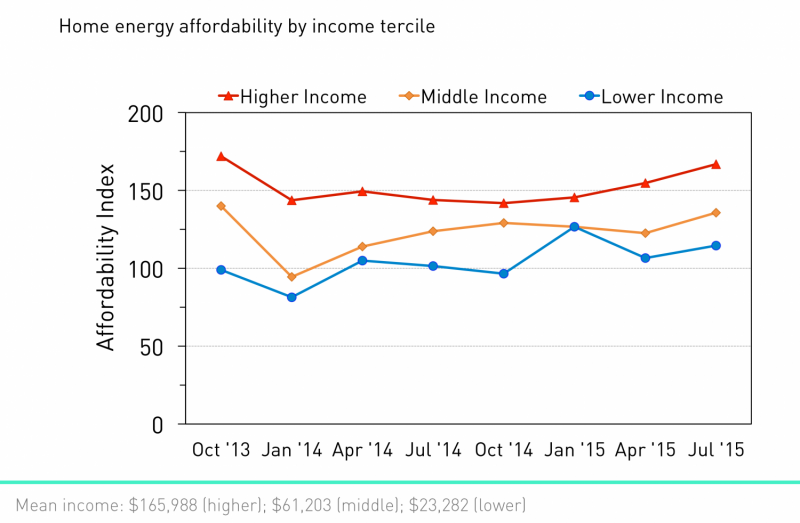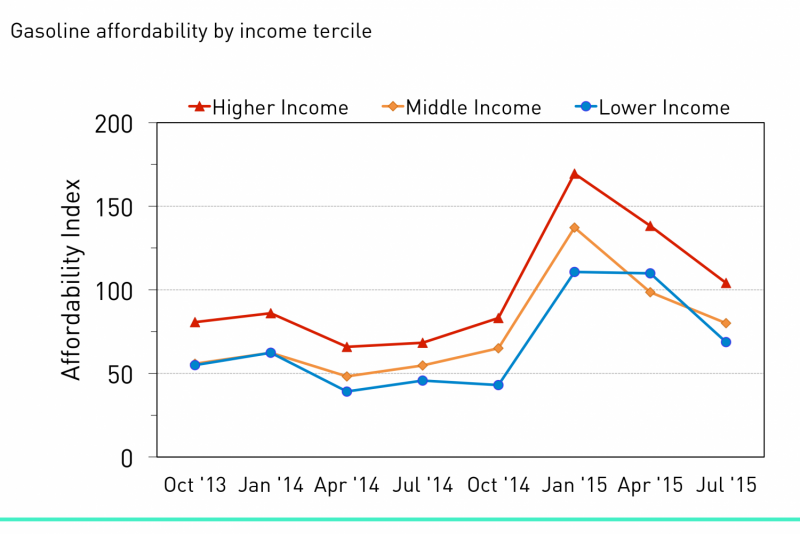Even with falling prices at the pump, consumers find home energy more affordable than gasoline

Consumers say their home energy bills would have to more than double before they become unaffordable, according to the University of Michigan Energy Survey.
The survey measures the affordability of consumer energy costs based on two key indicators: home energy bills and gasoline prices. Consumer sentiment regarding home energy expenses has remained stable over the past two years, but it proved more sensitive to changes in gasoline price.
The energy survey is a joint project of the university's Energy Institute and its Institute for Social Research. The survey runs quarterly as part of the long-running Surveys of Consumers, which is the source of the nationally recognized Index of Consumer Sentiment.
To create its energy affordability indices, researchers analyzed two years' worth of data that surveyed a total of 3,400 Americans on how they felt about their home energy bills and gasoline expenses. Consumers were asked how high an energy cost would have to rise before their household would find it unaffordable, in the sense of having to make lifestyle changes due to the expense.
To date, the affordability of energy has typically been studied through an economic lens. For example, researchers may set a household expenditure-based standard of living and then assess energy costs as a pre-determined share of a household budget assumed to sustain that standard.
However, "That's not how consumers really make decisions about their personal finances," said Amy Moors, the research fellow who is the lead analyst for the U-M Energy Survey. "Instead, asking people specifically about their personal thresholds of when they would find energy costs difficult to bear provides a clear picture of what consumers actually feel about the issue."

Consumer sentiment indices track changes in attitudes using a stable scale with which changes in views can be compared over time. For consumer energy affordability, an index of zero indicates that consumers are at the threshold at which they consider the energy expense to be unaffordable. An index value of 100 reflects a consumer belief that the cost of energy would have to double before it is viewed as unaffordable.
The average affordability index for home energy over the past two years was 125, indicating people believed they could afford more than a doubling in their home energy costs. The average affordability index for gasoline over the past two years was 80, or less than a doubling in the price per gallon.
U.S. consumers say, on average, that $5.50 per gallon of gasoline would be unaffordable. The national average pump price was $3.16 per gallon over this period.
John DeCicco, a research professor at the U-M Energy Institute and director of the Energy Survey, thinks the high visibility of gasoline prices play a role in shaping consumer perceptions of affordability.
"As has been said for years regarding the cost of fuel, 'What other price is plastered in big numbers at every other intersection across the country?'" he said. "Consumers have to fill their vehicles often and make a conscious decision to select a gas station, stand there watching the numbers climb on the pump and then immediately pay that amount.
"By contrast, home energy bills come monthly. Moreover, an increasing number of consumers use autopay and so may not even closely read their bills."
The gasoline affordability index proved very sensitive to the swings in pump price seen over the past two years.
"For gasoline, consumers' perceived affordability took a big jump as pump prices fell in January," DeCicco said. "Gasoline affordability has since declined, and consumers again believe that it is less affordable than home energy."
The U-M researchers also examined the affordability question by income, dividing survey respondents into three groups, or terciles, according to self-reported household income. For the highest-income group, who make an average of $166,000 each year, the affordability indices—99 for gasoline and 152 for home energy—were significantly higher than those for middle and lower income consumers, though not as high as researchers expected them to be (see chart).
"I was surprised by how little the responses of people in the highest income bracket differed from those of the lower income brackets," Moors said. "One would think that people with greater wealth could afford a much larger increase in their energy costs and respond to our survey accordingly. However, the affordability indices across the income brackets differ much less than might be implied by the large disparities in household income."
Using a nationally representative sample of U.S. households, the U-M Energy Survey probes consumer attitudes and beliefs about energy at a deep level, independently of particular sources or forms of energy. By eliciting public perceptions regarding key facets of energy—including affordability, reliability and environmental impact—it generates valuable research data that will foster well-informed public discussions of energy issues and policy for years to come.
More information: See the report online: energy.umich.edu/sites/default … 5-report_dec2015.pdf
Provided by University of Michigan




















